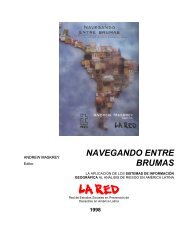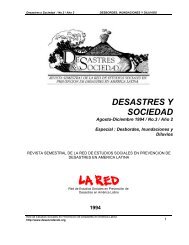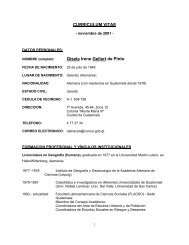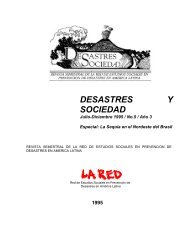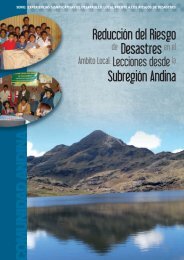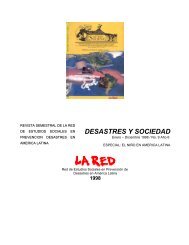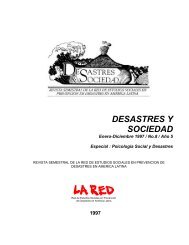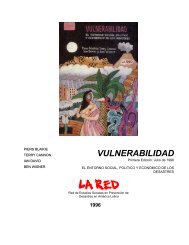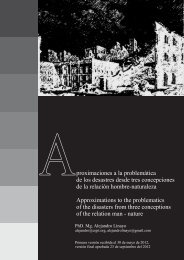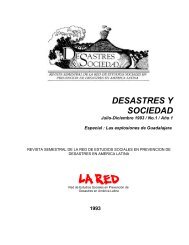Estrategias sociales de prevención y adaptación Social ... - La RED
Estrategias sociales de prevención y adaptación Social ... - La RED
Estrategias sociales de prevención y adaptación Social ... - La RED
You also want an ePaper? Increase the reach of your titles
YUMPU automatically turns print PDFs into web optimized ePapers that Google loves.
Yet there is also another story. While fomenting self-confi<strong>de</strong>nce and a <strong>de</strong>ep trust in<br />
<strong>de</strong>lta technology, the Dutch doggedness has also ero<strong>de</strong>d everyday awareness of flood risk.<br />
For a few <strong>de</strong>ca<strong>de</strong>s, the Dutch thought they were basically safe, give or take a few minor<br />
local inundations. Protests led to lower flood protection standards and slack zoning enforcement<br />
(greater risk acceptance), and plans to make space for the river. As we shall see,<br />
land reclamation projects have likewise run up against protests for their economic or environmental<br />
costs.<br />
These examples pointing at competing claims in Dutch flood management history that<br />
suggests multiple forces are at play. This is in contrast with a familiar trope: much literature<br />
in this domain is in the mo<strong>de</strong>rnist frame of ever greater progress, sketching a <strong>de</strong>velopment<br />
from a primitive mono-sectoral focus to an enlightened, integrated focus as end point [add<br />
some examples here].<br />
The upward arrow of progress, then, may not be the only or even the most apposite <strong>de</strong>scriptive<br />
metaphor. A pendulum swing between security-first (after a flood) and multiple concerns<br />
(as the memory of calamity fa<strong>de</strong>s) may prove to do the job equally well. Flood safety,<br />
it seems, always had to compete with other goals – land reclamation, shipping, salinisation<br />
and normalising rivers, fishing (Rooijendijk, 2009). As the memory of flood fa<strong>de</strong>d, these<br />
other goals became prevalent.<br />
A third metaphor is an ever recurring cycle. A helpful framework in this context, supporting<br />
this metaphor, may be Thomas Hartmann’s take on Douglas and Wildawsky’s<br />
(1982) Cultural Theory. The Cultural Theory of risk is based on the fundamental heuristic<br />
that four (or five, see Thompson, 1990) distinctive rationalities seem to exist with respect to<br />
the environment, informed by social organisation: an individualistic, an egalitarian, a hierarchical,<br />
and a fatalistic rationality towards nature. Thompson (2006) and Verweij (2006)<br />
have advocated the incorporation of these multiple rationalities, these contradictory certainties,<br />
into “holistic” projects and organizations.<br />
Rather than integrating the four, Hartmann (2010) sees a sequence over time with distinct,<br />
if overlapping, cultural rationalities. My take on this is not just to apply this i<strong>de</strong>a to the<br />
Netherlands, but to relate the cyclicality of cultural responses to the equally predictable resurgence<br />
of “best practices”. As there is no linear progress, there can also be space for preand<br />
postmo<strong>de</strong>rn elements in what is presented as “innovation”.<br />
Coming Full Circle - Once Again With Feeling… By way of illustration, let’s start from<br />
the right-hand corner (Fig. 1.1) in a flood event.<br />
Major floods have been formative experiences in Dutch history. Anthropologists point<br />
out that group i<strong>de</strong>ntity is usually rooted in war, and the Dutch “fight against the water”<br />
projects a cherished image of pulling together again and again against a common enemy. In<br />
a flood the rationality is egalitarian; “we”re all in this together”. The Dutch experienced one<br />
of these life-changing events in 1953, to such an extent that the February storm surge ranks<br />
only second to the German occupation of 1940-1945 as an historic benchmark.<br />
27



